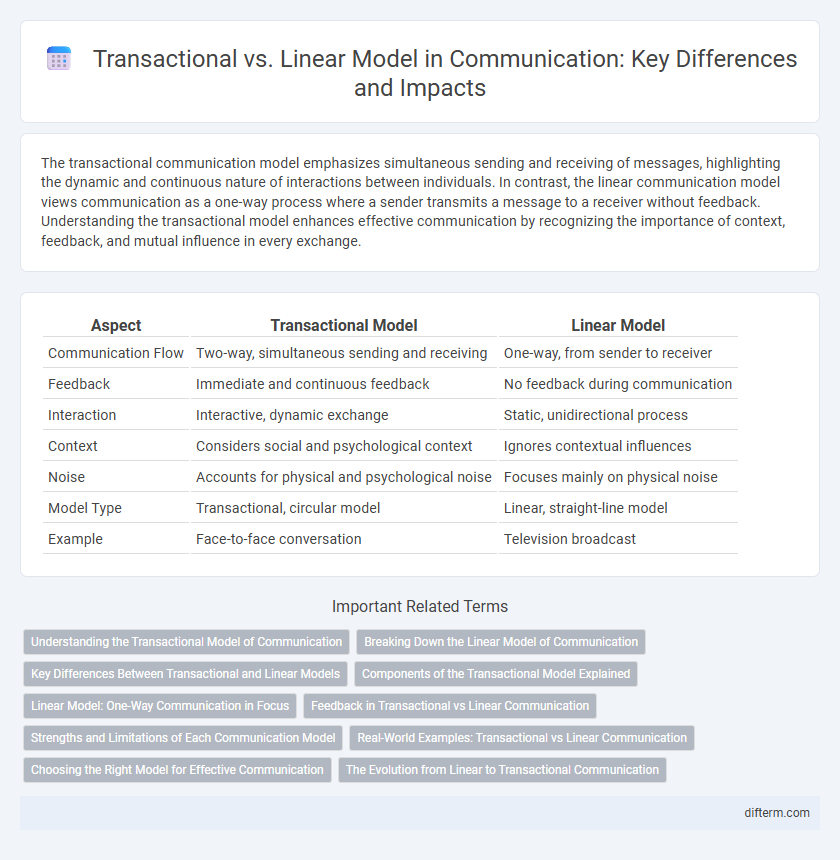The transactional communication model emphasizes simultaneous sending and receiving of messages, highlighting the dynamic and continuous nature of interactions between individuals. In contrast, the linear communication model views communication as a one-way process where a sender transmits a message to a receiver without feedback. Understanding the transactional model enhances effective communication by recognizing the importance of context, feedback, and mutual influence in every exchange.
Table of Comparison
| Aspect | Transactional Model | Linear Model |
|---|---|---|
| Communication Flow | Two-way, simultaneous sending and receiving | One-way, from sender to receiver |
| Feedback | Immediate and continuous feedback | No feedback during communication |
| Interaction | Interactive, dynamic exchange | Static, unidirectional process |
| Context | Considers social and psychological context | Ignores contextual influences |
| Noise | Accounts for physical and psychological noise | Focuses mainly on physical noise |
| Model Type | Transactional, circular model | Linear, straight-line model |
| Example | Face-to-face conversation | Television broadcast |
Understanding the Transactional Model of Communication
The transactional model of communication emphasizes the dynamic and simultaneous exchange of messages between sender and receiver, highlighting feedback and context as essential components. Unlike the linear model, it recognizes communication as a continuous, reciprocal process where both parties act as communicators and receivers simultaneously. This model accounts for noise, environment, and shared experiences, offering a more accurate representation of real-world interactions.
Breaking Down the Linear Model of Communication
The linear model of communication simplifies the process into a one-way transmission of messages from sender to receiver, lacking feedback mechanisms that limit interaction. It primarily emphasizes encoding, message transmission, and decoding without accounting for noise or context, reducing its effectiveness in dynamic communication scenarios. Understanding its limitations highlights the importance of adopting interactive or transactional models that capture the complexity of real-world communication exchanges.
Key Differences Between Transactional and Linear Models
The transactional model of communication emphasizes the simultaneous and dynamic exchange of messages, where both sender and receiver engage in feedback and context shapes understanding. In contrast, the linear model presents communication as a one-way process, with a sender transmitting a message to a passive receiver without feedback or interaction. Key differences include the presence of feedback, the role of context, and the interactive nature inherent in the transactional model versus the unidirectional flow of information in the linear model.
Components of the Transactional Model Explained
The transactional model of communication involves components such as sender, receiver, message, channel, feedback, and context, emphasizing simultaneous sending and receiving of messages. Unlike the linear model, it accounts for noise and the dynamic exchange where both parties create meaning collaboratively. This model reflects real-life communication more accurately by incorporating feedback loops and acknowledging environmental and psychological factors influencing interaction.
Linear Model: One-Way Communication in Focus
The Linear Model of communication represents a one-way transmission where the sender encodes and sends a message directly to the receiver without feedback or interaction. This model is fundamental in broadcast, advertising, and public announcements where information flows in a single direction. Its simplicity highlights the importance of clear encoding and effective message delivery to ensure comprehension in communication processes.
Feedback in Transactional vs Linear Communication
Feedback in transactional communication is immediate and continuous, allowing both sender and receiver to simultaneously exchange messages and adjust responses in real time. In contrast, linear communication follows a one-way process where feedback is typically absent or delayed, limiting interaction to a simple transmission of information. Effective communication models prioritize feedback to enhance understanding and engagement between parties.
Strengths and Limitations of Each Communication Model
The transactional communication model emphasizes dynamic interaction, highlighting its strength in recognizing feedback and simultaneous message exchange, which enhances mutual understanding in real-time. However, its complexity can sometimes obscure clear message interpretation, especially in networks with multiple participants. The linear communication model excels in its straightforward, one-way message delivery, making it effective for simple or mass communication, but it lacks feedback mechanisms, limiting adaptability and often resulting in message distortion or misinterpretation.
Real-World Examples: Transactional vs Linear Communication
Transactional communication models illustrate real-world scenarios like face-to-face conversations where sender and receiver simultaneously exchange messages, such as in team meetings or video calls, enhancing interaction and feedback. Linear communication models are evident in one-way information dissemination, like television broadcasts or public announcements, where the sender transmits a message without immediate feedback from the receiver. Understanding these models highlights the dynamic nature of human interaction versus the straightforward transmission of information in various communication contexts.
Choosing the Right Model for Effective Communication
Choosing the right communication model is crucial for enhancing message clarity and engagement. The transactional model emphasizes simultaneous sending and receiving of messages, fostering interactive and dynamic exchanges, while the linear model highlights one-way communication, suitable for straightforward information delivery. Effective communicators assess context, audience, and purpose to select between these models, optimizing understanding and feedback.
The Evolution from Linear to Transactional Communication
The evolution from linear to transactional communication reflects a shift from one-way message transmission to dynamic, interactive exchanges where sender and receiver roles continuously overlap. Unlike the linear model, which views communication as a straightforward process, the transactional model emphasizes simultaneous feedback, context, and mutual influence, enhancing understanding. This progression highlights the complexity of human communication and its reliance on shared environments and co-created meaning.
transactional vs linear (model) Infographic

 difterm.com
difterm.com